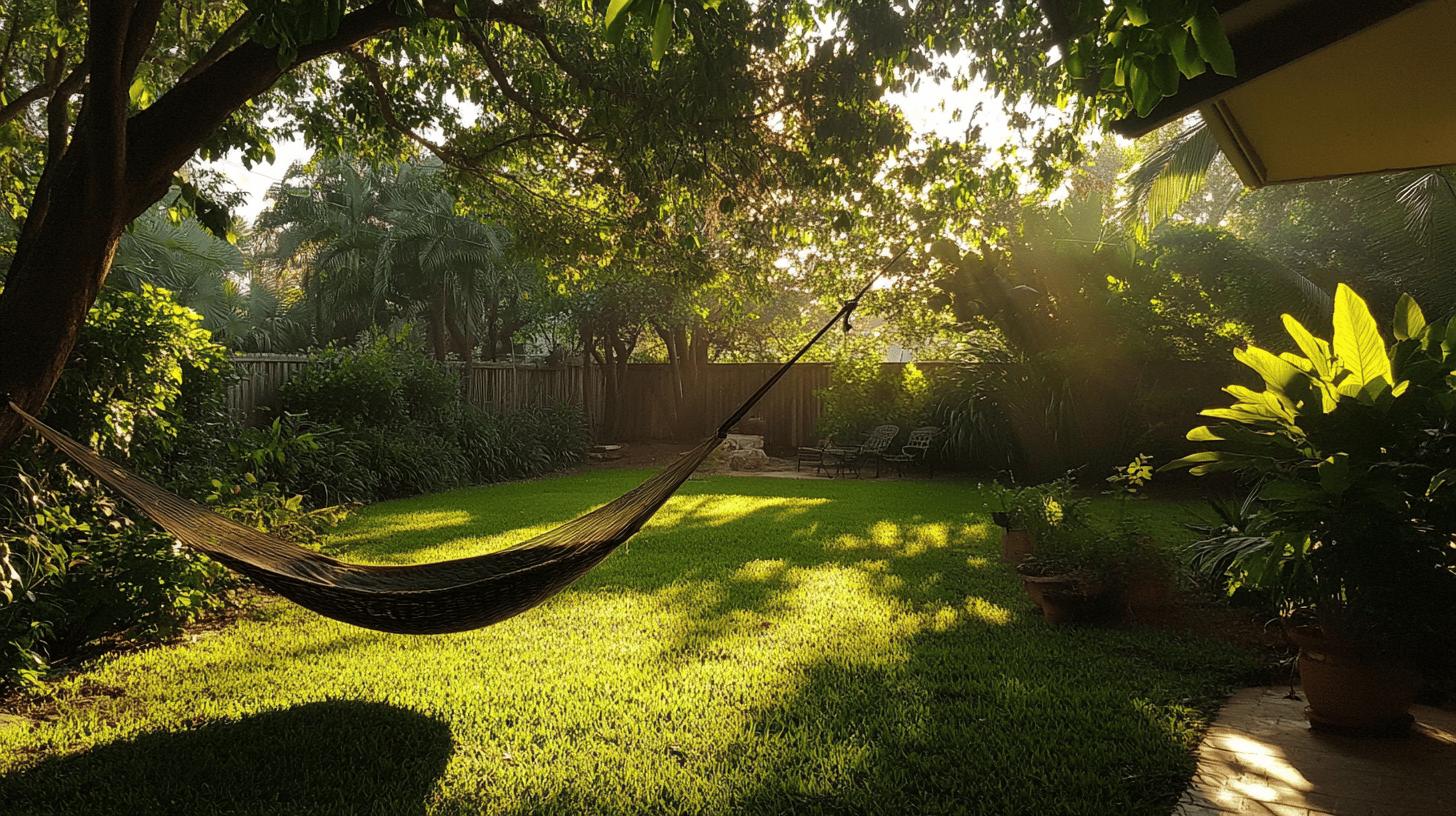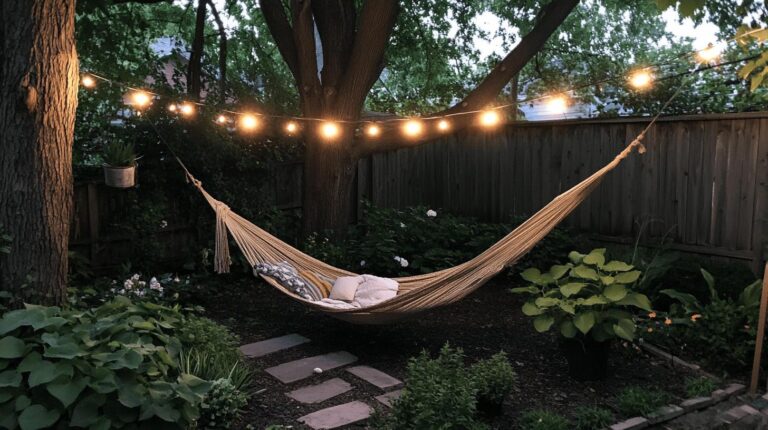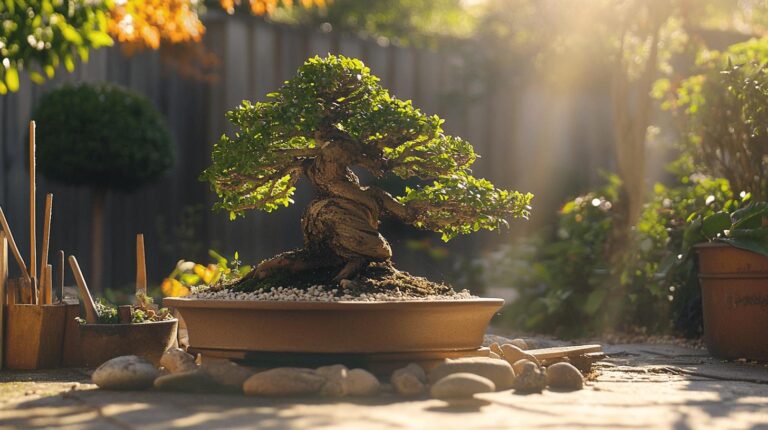How to Transform Your Backyard into a Relaxation Oasis
Have you ever dreamed of transforming your ordinary backyard into a peaceful retreat? A special place where you can escape from daily stress and find a moment of calm right at home? You’re not alone! Many homeowners are discovering the joy of creating their own backyard sanctuary.
In this guide, we’ll walk through practical steps to turn your outdoor space into a personal haven. From clearing clutter to adding soothing water features, comfortable seating, and tranquil garden spaces – your dream backyard oasis is within reach. Let’s explore how to make this transformation happen!
Start Fresh: Clearing the Way for Your Backyard Oasis
The first step toward creating any relaxing space is removing what doesn’t belong. Overgrown shrubs, forgotten toys, and broken furniture can make even the nicest yard feel chaotic and unwelcoming.
Begin by taking a weekend to thoroughly clean your outdoor space. This means:
- Pruning overgrown plants that block pathways or views
- Removing weeds that compete with your desired plants
- Clearing away unused items like old toys, sports equipment, or tools
- Repairing or removing broken furniture, planters, or decorations
- Organizing garden tools and outdoor supplies in a storage solution
This initial cleanup immediately transforms how your space feels and provides a blank canvas for creating something special. Plus, the satisfaction of seeing a tidy yard will motivate you to take the next steps in your backyard makeover.
Essential Features for Your Backyard Retreat
Once your space is clean and organized, it’s time to incorporate elements that create a truly relaxing atmosphere. Here are five must-have features that transform an ordinary yard into an oasis:
1. Comfortable Seating: The Heart of Relaxation
Comfortable seating is perhaps the most important element of any backyard retreat. After all, you can’t relax if you don’t have a comfortable place to sit or lounge!
Consider these options based on how you plan to use your space:
- Deep seating sets: Perfect for conversation areas where family and friends gather
- Lounge chairs: Ideal for sunbathing or reading
- Hammocks: The ultimate relaxation piece for afternoon naps
- Outdoor sectionals: Great for larger families or frequent entertainers
- Dining sets: Essential if you enjoy outdoor meals
When selecting outdoor furniture, look for pieces with weather-resistant frames and plush, water-resistant cushions. Memory foam cushions provide exceptional comfort but require proper storage during rainy periods. Meanwhile, regular foam cushions dry more quickly after light rain but may not be as comfortable for extended sitting.
2. Shade Solutions: Creating Comfort in Any Weather
Even the most beautiful backyard becomes unusable during peak sun hours without adequate shade. Protecting yourself from harmful UV rays also allows you to enjoy your outdoor space longer and more comfortably.
Consider these shade options based on your needs:
- Umbrellas: Affordable, portable, and available in many sizes and colors
- Pergolas: Provide partial shade and can be enhanced with climbing plants or fabric
- Shade sails: Modern, affordable options that create dramatic visual interest
- Retractable awnings: Flexible protection that can be adjusted as the sun moves
- Gazebos: Permanent structures that provide full shade and weather protection
For maximum flexibility, combine multiple shade solutions. For instance, a pergola might cover your main seating area, while umbrellas provide additional shade for dining spaces or lounging areas.
3. Water Features: The Sound of Serenity
There’s something magical about the sound of flowing water. It naturally masks neighborhood noise and creates a peaceful soundtrack for relaxation. Even small water features can dramatically transform the atmosphere of your backyard.
Water feature options include:
- Tabletop fountains: Perfect for small spaces or patios
- Bird baths: Attract beautiful wildlife while adding a water element
- Wall fountains: Save floor space while adding visual and auditory interest
- Small ponds: Create an ecosystem that supports plants and possibly fish
- Pondless waterfalls: Provide the sound and sight of falling water without maintenance concerns
When choosing a water feature, consider maintenance requirements. Recirculating fountains typically require the least upkeep, while ponds with fish need regular attention to maintain water quality and animal health.
4. Privacy Screens: Creating Your Own Secret Garden
It’s difficult to truly relax if you feel exposed to neighbors or passersby. Creating privacy transforms how you experience your outdoor space, making it feel like a true extension of your home.
Effective privacy solutions include:
- Tall privacy fences: Provide immediate and complete screening
- Living screens: Plants like arborvitae, bamboo, or tall ornamental grasses
- Lattice panels: Allow light and air circulation while blocking sightlines
- Outdoor curtains: Add softness and can be opened or closed as needed
- Decorative panels: Modern laser-cut screens add privacy and artistic elements
For the most natural effect, consider layering different privacy elements. A basic fence might be enhanced with climbing plants, while decorative panels can divide areas within your yard to create intimate spaces for different activities.
5. Ambient Lighting: Extending Your Enjoyment Into Evening
The right lighting extends your outdoor enjoyment well past sunset and creates a magical atmosphere. A thoughtful lighting plan balances practical illumination with mood-setting accents.
Consider these lighting options:
- Path lights: Guide movement through your space safely
- String lights: Create a festive overhead canopy
- Lanterns: Add portable illumination and decorative elements
- Uplights: Highlight trees or architectural features
- Fire features: Provide natural, warm light and a gathering spot
Solar-powered options have improved significantly in recent years, offering an energy-efficient alternative that doesn’t require complicated wiring. For maximum flexibility, incorporate lighting at different heights – ground-level path lights, table lamps at seating height, and overhead string lights create a well-layered lighting scheme.
Personal Touches: Making Your Backyard Uniquely Yours
While the core elements above create the foundation of a relaxing space, personal touches make your backyard feel like home. These are the details that reflect your personality and make the space truly yours.
Consider adding:
- Colorful cushions and throw pillows: Easy to change seasonally
- Outdoor rugs: Define spaces and add comfort underfoot
- Garden art: Sculptures, wind chimes, or decorative stakes
- Container gardens: Showcase favorite plants and add color
- Personal mementos: Weather-resistant items that hold special meaning
These personal elements should evolve over time. Rather than purchasing everything at once, allow your space to grow organically as you find pieces that speak to you. This creates a more authentic environment that genuinely reflects your taste and lifestyle.
Selecting the Perfect Outdoor Lounge Furniture
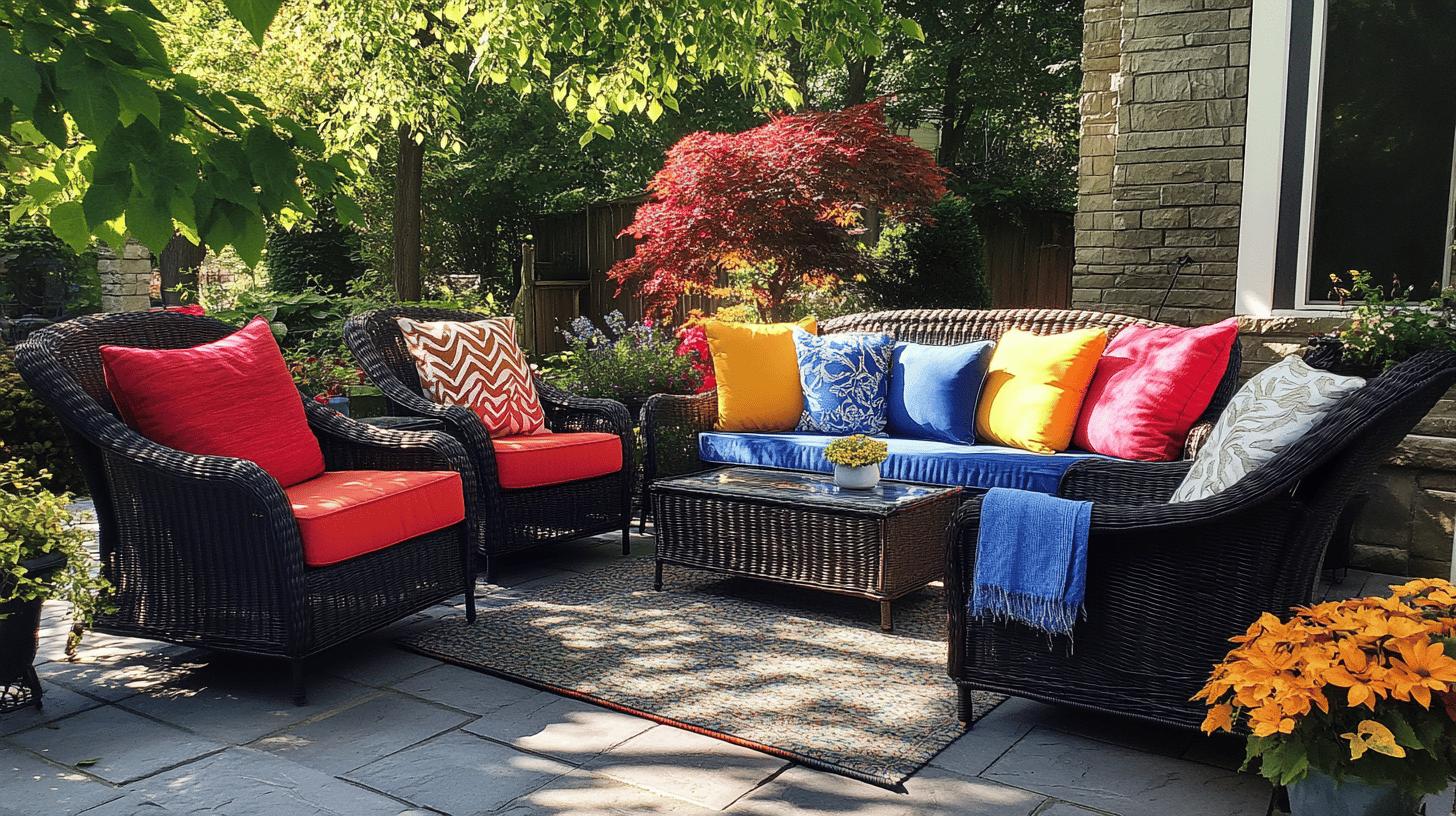
The right outdoor furniture creates the foundation for relaxation. Comfort, durability, style, and maintenance needs should all factor into your selection process.
Materials Matter: Balancing Durability and Comfort
Different materials offer various benefits and challenges for outdoor furniture:
- Teak and other hardwoods: Beautiful, naturally weather-resistant, but require occasional oiling to maintain color
- All-weather wicker: Lightweight, comfortable, available in many styles
- Aluminum: Rust-proof, lightweight, and available in many finishes
- Recycled plastic: Virtually maintenance-free, environmentally friendly, and available in many colors
- Steel: Strong and sturdy but may rust without proper protection
The best choice depends on your climate, available storage, and maintenance preferences. In coastal areas, aluminum resists salt damage. In rainy regions, quick-drying materials like synthetic wicker with fast-drying cushions work well. In hot, sunny areas, materials that remain cool to the touch like wood or plastic are preferable.
Four Essential Features for Outdoor Furniture
When selecting outdoor lounge furniture, prioritize these key characteristics:
1. Weather Resistance
The best outdoor furniture withstands sun, rain, and temperature fluctuations. Look for:
- UV-resistant fabrics that won’t fade
- Rust-proof or rust-resistant metals
- Mold and mildew-resistant cushions
- Properly sealed woods or composites
2. Ease of Maintenance
Your relaxation space shouldn’t create extra work. Choose pieces that:
- Can be cleaned with simple soap and water
- Don’t require frequent treatments or special products
- Have removable, washable cushion covers
- Store easily when not in use
3. Style Compatibility
Your outdoor furniture should complement your home’s architecture and your personal taste:
- Contemporary homes pair well with clean lines and metal frames
- Traditional homes often suit natural materials like wood and wicker
- Coastal homes benefit from weather-resistant wood looks and blue tones
- Eclectic spaces can mix materials for a personalized look
4. Versatility and Adaptability
Flexible furniture arrangements accommodate different activities:
- Modular seating can be reconfigured for conversations or solo relaxation
- Nesting tables provide extra surface space when needed
- Stackable chairs store compactly when not in use
- Adjustable loungers adapt to different positions
Comfort Enhancements: Beyond the Basics
Transform basic outdoor furniture into luxurious lounging spaces with these additions:
- High-quality cushions: Look for 5+ inches of thickness for chairs and 6+ inches for deep seating
- Outdoor pillows: Add back support and pops of color
- Side tables: Keep drinks, books, and devices within easy reach
- Outdoor ottomans: Provide foot support or extra seating
- Weather-resistant throws: Add warmth for cool evenings
With comfortable, durable furniture as your foundation, your backyard becomes a place where you naturally want to spend time, whether enjoying your morning coffee, reading a book, or hosting friends.
Garden Retreat: Creating a Plant Paradise
Plants transform a backyard from a simple outdoor space into a living sanctuary. Beyond their beauty, plants provide oxygen, filter air pollutants, and create natural cooling through shade and transpiration.
Selecting Plants for Year-Round Interest
A truly relaxing garden offers something special in every season. When selecting plants, consider their seasonal appeal:
Spring Bloomers:
- Tulips, daffodils, and other spring bulbs
- Flowering shrubs like azaleas and rhododendrons
- Early perennials like columbine, bleeding heart, and lungwort
Summer Stars:
- Long-blooming perennials like coneflower, black-eyed Susan, and daylilies
- Flowering annuals for continuous color
- Ornamental grasses that add movement and texture
Fall Performers:
- Plants with colorful autumn foliage like maple trees or burning bush
- Late-season bloomers like asters, mums, and sedum
- Ornamental grasses reaching their full, feathery maturity
Winter Interest:
- Evergreen trees and shrubs that provide structure
- Plants with interesting bark like paperbark maple or river birch
- Shrubs with colorful berries like winterberry holly
- Plants with architectural seed heads or stems
For a low-maintenance approach, focus on native plants adapted to your region’s conditions. These typically require less water, fertilizer, and pest control once established.
Creating Multi-Sensory Garden Experiences
A truly relaxing garden engages all the senses:
Sight: Include varied colors, forms, and textures. Create visual rhythm by repeating colors or forms throughout the garden.
Sound: Incorporate plants that rustle in the breeze like ornamental grasses or quaking aspen. Consider plants that attract songbirds, such as serviceberry or coneflower.
Smell: Place fragrant plants near seating areas or pathways where you’ll enjoy their scent:
- Herbs like lavender, mint, and rosemary
- Flowering shrubs like lilac or mock orange
- Fragrant perennials like phlox or lily
Touch: Include plants with interesting textures to engage tactile senses:
- Soft, fuzzy plants like lamb’s ear
- Smooth, cool leaves like hostas
- Rough textures like ornamental grasses
Taste: Incorporate edible plants that double as ornamentals:
- Blueberry bushes (excellent fall color)
- Strawberries (beautiful groundcover)
- Herbs with ornamental value like purple basil or bronze fennel
By engaging multiple senses, your garden creates a fully immersive relaxation experience that helps you disconnect from everyday stress.
Plant Arrangement for Maximum Impact
How you arrange plants significantly affects both their visual appeal and maintenance needs:
- Layer plants by height: Tall plants in back, medium in middle, shortest in front
- Group plants with similar needs: This simplifies watering and care
- Create plant communities: Mimic natural groupings that look and grow well together
- Plan for mature sizes: Avoid future overcrowding by spacing properly
- Incorporate repetition: Repeat key plants or colors to create visual cohesion
For the most relaxing effect, favor curving, flowing lines over rigid geometric patterns. Informal, naturalistic plantings typically create a more soothing atmosphere than formal, symmetrical designs.
Enhancing Backyard Privacy: Creating Your Secret Garden
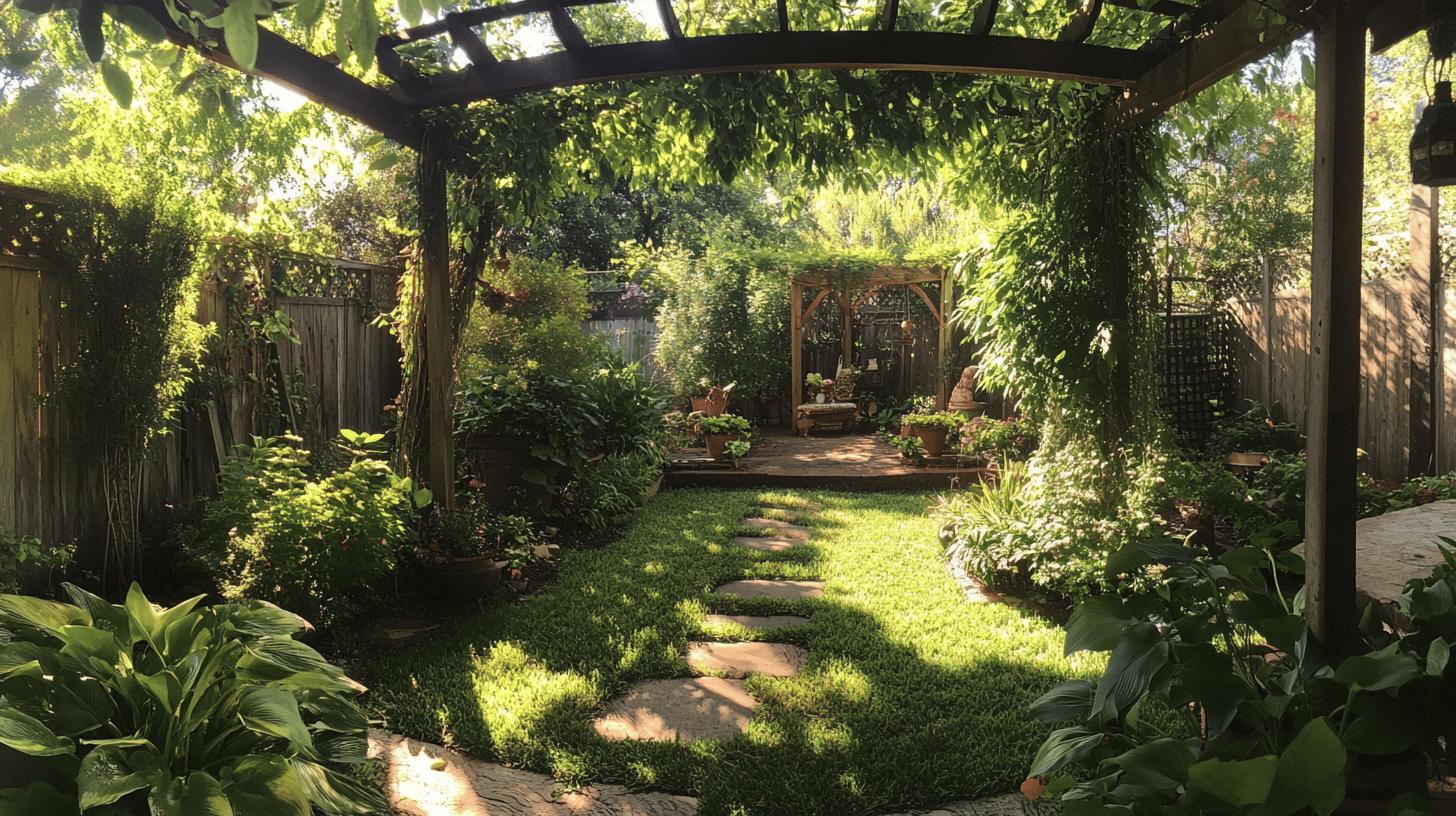
Privacy transforms how you experience your outdoor space. Without it, you might feel self-conscious or exposed instead of relaxed and at ease.
The Psychology of Privacy in Outdoor Spaces
Research shows that having a sense of enclosure and privacy significantly increases how often people use their outdoor spaces and how long they stay. This “prospect and refuge” concept suggests we naturally prefer spaces where we can see out (prospect) while feeling protected (refuge).
Creating privacy doesn’t mean building fortress-like walls around your property. Instead, think of creating “outdoor rooms” with varying degrees of enclosure that serve different purposes:
- Fully enclosed spaces for intimate conversations or meditation
- Partially screened areas for casual gatherings
- Open areas that connect with the broader landscape
Effective Privacy Solutions for Any Space
Different privacy challenges require different solutions:
For Overlooking Windows or Balconies:
- Strategically placed trees or tall shrubs
- Pergolas with climbing vines
- Tall container plantings on platforms
For Side Yards and Property Lines:
- Mixed hedges combining deciduous and evergreen plants
- Decorative fence panels with plantings
- Staggered privacy screens that block views without creating a solid wall
For Creating “Rooms” Within Your Yard:
- Movable planters with tall plants
- Outdoor curtains or shade sails
- Ornamental grass plantings that sway in the breeze
Creating Privacy That Enhances Your Space
The most successful privacy solutions serve multiple purposes:
Living Screens That Support Wildlife:
- Native hedges that provide berries for birds
- Flowering vines that attract pollinators
- Mixed shrub borders with year-round habitat value
Edible Privacy Plantings:
- Espaliered fruit trees along fences
- Berry bushes like blueberry or raspberry as informal hedges
- Herb walls in vertical planters
Privacy Elements That Add Beauty:
- Decorative screens with interesting patterns
- Architectural panels that cast beautiful shadows
- Vine-covered structures that change seasonally
By thinking beyond basic fencing, your privacy solutions become features that enhance your yard rather than just blocking unwanted views.
Lighting Your Backyard Oasis: Creating Evening Magic
Well-designed outdoor lighting transforms your backyard after sunset, creating a magical atmosphere while extending usable hours. The right lighting plan balances practical needs with aesthetic goals.
The Science of Relaxing Light
Light significantly affects mood and relaxation. For the most soothing evening environment:
- Use warm white light (2700K-3000K) rather than cool blue-toned light
- Keep brightness levels low to moderate
- Avoid harsh, direct light that creates strong shadows
- Use multiple light sources at different heights rather than a few bright fixtures
- Include areas of darkness to create contrast and visual interest
These principles mirror natural twilight conditions that naturally signal our bodies to relax and wind down.
Layered Lighting for Different Purposes
Professional landscape designers use three layers of lighting:
Ambient Lighting:
- Provides overall illumination
- Creates general visibility and safety
- Examples: overhead string lights, lanterns, gentle wash lighting on fences
Task Lighting:
- Illuminates specific activities
- Provides focused, practical light
- Examples: grill lights, pathway lighting, step lights
Accent Lighting:
- Highlights special features
- Creates visual interest and mood
- Examples: uplighting trees, illuminating water features, grazing textured walls
A well-balanced lighting plan includes all three layers, with the ability to control different zones separately based on your needs.
Sustainable Lighting Options
Energy-efficient outdoor lighting reduces both environmental impact and operating costs:
Solar-Powered Lighting:
- Requires no electrical wiring
- Free to operate
- Best for accent lighting and areas that receive full sun
- Technology has improved significantly in recent years
Low-Voltage LED Systems:
- Use minimal electricity
- Bulbs last 15+ years
- Can be connected to smart home systems
- Provide consistent brightness regardless of weather
Battery-Powered Options:
- Offer flexibility for temporary or seasonal lighting
- Many now include USB recharging
- Great for table lamps or portable lighting
- Some include remote controls or timers
With thoughtful lighting design, your backyard becomes an evening retreat that’s perfect for unwinding after a long day or entertaining friends well into the night.
Fire Features: Creating Backyard Focal Points
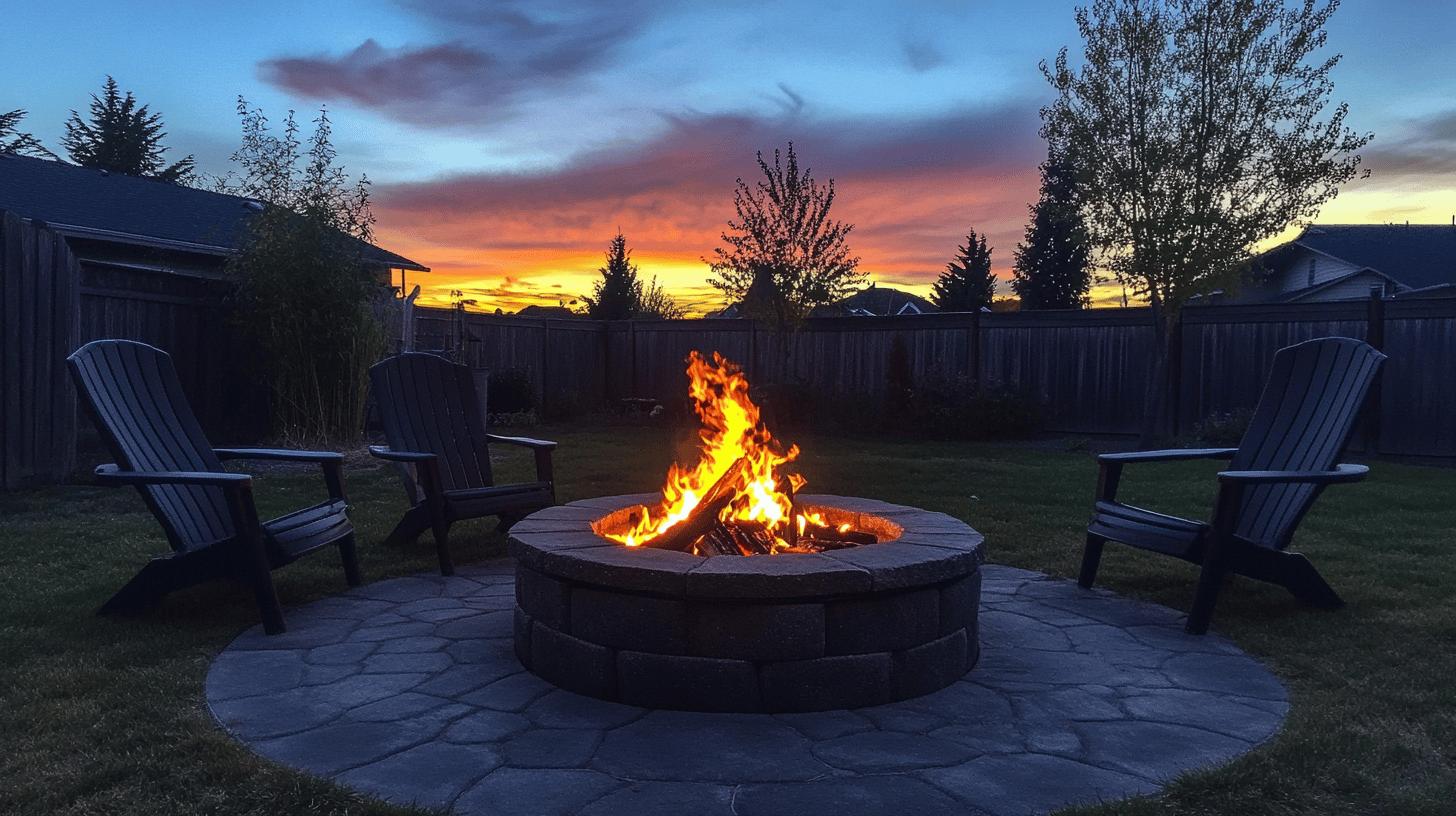
Few elements create a more natural gathering space than fire. Whether it’s a simple portable fire pit or an elaborate outdoor fireplace, adding fire to your backyard creates instant ambiance and practical warmth that extends your outdoor season.
The Social Psychology of Fire
Humans have gathered around fire for thousands of years, and this ancient connection remains powerful. Research shows that fire features:
- Naturally draw people together in circular arrangements that encourage conversation
- Lower blood pressure and induce relaxation when viewed
- Create shared experiences and memories
- Extend outdoor gatherings as temperatures drop
Even when not lit, fire features serve as natural focal points that help organize your outdoor space.
Types of Fire Features for Every Space and Budget
From simple to elaborate, there’s a fire feature for every yard:
Portable Fire Pits:
- Affordable starting point (beginning around $50)
- Can be stored when not in use
- Available in wood-burning, propane, or natural gas models
- Can be moved around your yard as needed
Built-In Fire Pits:
- Permanent installation that anchors a space
- Available in many sizes and materials
- Can be wood-burning or gas-fueled
- Often include seating walls or surrounding patio
Tabletop Fire Features:
- Perfect for small spaces or dining tables
- Typically fuel-gel or small propane tanks
- Portable and versatile
- Add ambiance without significant heat
Outdoor Fireplaces:
- Make the strongest architectural statement
- Provide more directed heat and wind protection
- Can include wood storage, seating, or even pizza ovens.
- Typically the most expensive option
Fire Tables:
- Combine fire feature with functional table surface
- Usually propane or natural gas
- Control flames with adjustable settings
- Provide both warmth and practical surface area
Safety Considerations for Fire Features
To safely enjoy your fire feature:
- Place it on non-flammable surfaces like stone, concrete, or specially designed fire mats
- Maintain at least 10-15 feet of clearance from structures, trees, and flammable materials
- Keep a fire extinguisher, garden hose, or bucket of sand nearby
- Follow all manufacturer guidelines for fuel types and usage
- Consider wind patterns and place fire features where smoke won’t blow toward seating or into open windows
- Check local regulations regarding open flames, which vary widely between communities
With proper planning and safety measures, a fire feature becomes the heart of your backyard oasis—a place where relaxation, conversation, and connection naturally occur.
Designing a Meditation Space: Creating Your Outdoor Sanctuary
A dedicated meditation space provides a special retreat for mindfulness practices, quiet contemplation, or simply disconnecting from technology and daily stresses. Even a small corner of your yard can become a powerful tool for mental wellness.
Benefits of Outdoor Meditation Spaces
Spending time in a dedicated outdoor meditation area offers unique advantages:
- Natural surroundings reduce stress hormones more effectively than indoor spaces
- Connection with nature enhances mindfulness
- Natural sounds provide background noise that’s more conducive to relaxation than indoor environments
- Changing seasons and weather create varied meditation experiences
- Physical separation from indoor distractions helps the mind shift into a different mode
Essential Elements of a Meditation Space
The most effective meditation spaces include:
Comfortable Seating:
- Weather-resistant meditation cushions
- Simple benches with proper height for alignment
- Small platform deck raised slightly above ground level
- Smoothed stone or stump seating for a natural approach
Physical Boundaries:
- Partial enclosure that creates a sense of separation
- Changes in flooring material (stepping stones, deck, gravel)
- Symbolic thresholds like a small gate or opening between plants
- Vertical elements like trellises or tall grasses that create walls
Sensory Elements:
- Plants with calming scents like lavender or lemon balm
- Gentle sounds from wind chimes, small fountains, or rustling grasses
- Textural elements that ground you in the present moment
- Simple visual focal points like a small statue, interesting stone, or special plant
Creating a Multi-Seasonal Meditation Space
To use your meditation space year-round:
- Include evergreen plants for winter structure
- Consider a small pergola with removable sides for weather protection
- Install a heating element like a small infrared heater for cooler months
- Include seating that won’t retain water after rain
- Position the space to catch morning sun in winter and afternoon shade in summer
With thoughtful design, your meditation space becomes a healing sanctuary that you’ll naturally turn to when you need to reset and recharge.
Water Features: The Ultimate Backyard Enhancement
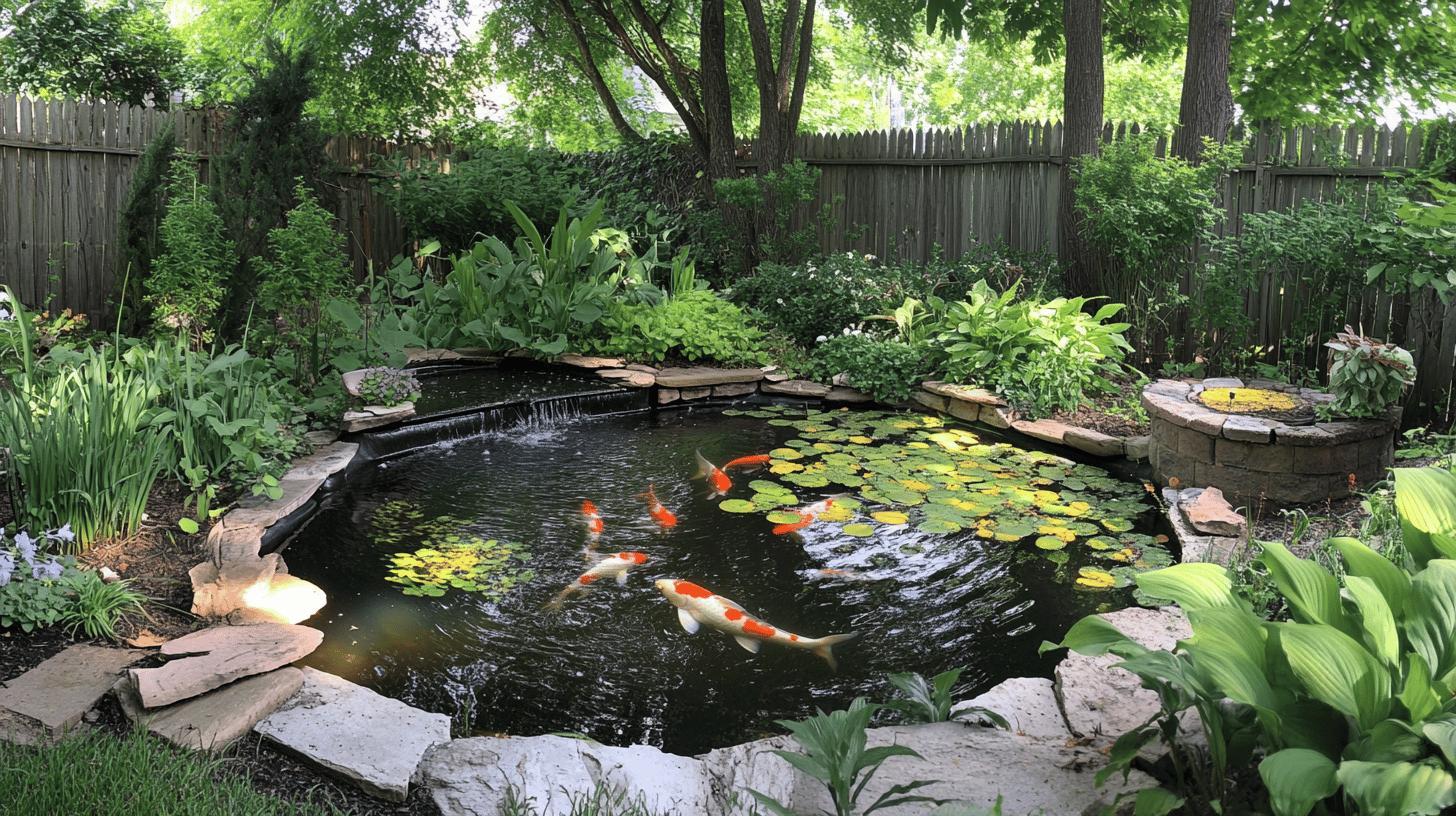
Water features create a multi-sensory experience that transforms any outdoor space. The sight and sound of water taps into something primal in human psychology, creating instant relaxation and connection with nature.
The Science of Why Water Features Work
Water features contribute to relaxation in several ways:
- Moving water produces negative ions that may improve mood and reduce stress
- The sound of water creates “white noise” that masks traffic, neighbors, and other distractions
- Watching water’s movement naturally induces a meditative state
- Water attracts birds and beneficial insects, adding life to your space
- The reflective quality of still water makes spaces appear larger and adds dramatic light effects
Water Feature Options for Different Spaces and Budgets
From compact tabletop fountains to elaborate ponds, there’s a water feature for every yard:
Container Water Gardens:
- Perfect for small spaces including patios
- Can be created in virtually any watertight container
- May include small aquatic plants and possibly mini water lilies
- Minimal investment starting around $100
- Can be drained and stored during winter
Wall Fountains:
- Take up minimal floor space
- Create vertical interest
- Available in countless styles from modern to classical
- Can be attached to existing walls or fences
- Self-contained with recirculating pumps
Disappearing Fountains:
- Water bubbles up and then disappears into a hidden reservoir
- No standing water (safer for homes with small children)
- Lower maintenance than ponds
- Less water loss from evaporation
- Can be created with decorative urns, natural stone, or sculptural elements
Pondless Waterfalls:
- Provide sound and movement without open water
- Relatively low maintenance
- Can be built on sloped areas of your yard
- Create natural-looking streams and falls
- Water disappears into a gravel-covered reservoir
Traditional Ponds:
- Create complete aquatic ecosystems
- Can support fish and diverse water plants
- Become a backyard focal point
- Offer the most naturalistic appearance
- Require the most maintenance and initial investment
Maintenance Considerations for Water Features
Different water features require different levels of care:
Daily to Weekly Tasks:
- Check water levels and top off as needed
- Remove debris like fallen leaves or twigs
- Ensure pumps are functioning properly
Monthly Tasks:
- Clean filters as needed
- Check for any pump or liner issues
- Treat water if necessary (especially for ponds with fish)
Seasonal Tasks:
- Fall: Consider netting to keep leaves out
- Winter: Either keep running with a de-icer or drain depending on your climate
- Spring: Clean thoroughly and restart system if winterized
- Summer: Monitor water quality during hot periods
With proper selection and maintenance, water features provide years of enjoyment while significantly enhancing your backyard’s relaxation potential.
Creating a Zen Garden: Minimalist Peace
Zen gardens, also known as Japanese rock gardens or “karesansui,” offer a unique approach to creating tranquility through mindful arrangement of simple elements. These gardens originated in Japanese Zen Buddhist temples as aids to meditation and contemplation.
Philosophy and Purpose of Zen Gardens
Traditional Zen gardens embody several key principles:
- Simplicity (kanso): Using only essential elements
- Naturalness (shizen): Creating arrangements that feel organic rather than artificial
- Austerity (koko): Finding beauty in restraint
- Tranquility (seijaku): Creating a sense of calm and stillness
Unlike Western gardens that often emphasize abundant flowers and color, Zen gardens focus on creating landscapes that encourage mental clarity and inner peace through careful arrangement of minimal elements.
Core Elements of a Zen Garden
Traditional Zen gardens include:
Gravel or Sand:
- Represents water or emptiness
- Raked into patterns symbolizing waves or ripples
- Creates a neutral background for other elements
- The act of raking becomes a meditative practice itself
Stones:
- Represent mountains or islands
- Carefully selected for shape, texture, and character
- Arranged in asymmetrical groupings (typically in odd numbers)
- Partially buried to appear naturally emerging from the earth
Minimal Plantings:
- Moss: Represents land or forests
- Evergreens: Provide year-round structure and are often pruned into cloud-like forms
- Bamboo: Symbolizes flexibility and resilience
- Japanese maples: Add seasonal color change
Boundaries:
- Low walls or fences that create enclosure
- Simple entryways that mark transition
- Bamboo screens that filter views
- Subtle changes in level or material
Creating Your Own Zen-Inspired Space
While traditional Zen gardens follow strict rules, a home garden can adopt key principles while adapting to your space and preferences:
For Small Spaces:
- Create a miniature desktop Zen garden for daily contemplation
- Transform a corner of your yard with a simple gravel area and single focal stone
- Use a large container filled with sand/gravel and minimal elements
For Larger Areas:
- Define a specific area rather than trying to convert your entire yard
- Use existing trees or shrubs as backdrop elements
- Create viewing areas where you can contemplate the garden from different angles
Contemporary Adaptations:
- Incorporate local stone types available in your region
- Add elements with personal significance alongside traditional components
- Use modern materials like concrete or metal for boundaries and containers
The most important aspect of creating a Zen-inspired garden is approaching the process mindfully. Take time to consider each element’s placement, viewing the garden as a living artwork that evolves with the seasons and your own spiritual practice.
Bringing It All Together: Your Personalized Backyard Retreat
Creating a backyard oasis isn’t about following strict rules or adhering to specific styles. Instead, it’s about crafting outdoor spaces that support relaxation in ways that work specifically for you. The most successful backyard retreats reflect the personalities and needs of the people who use them.
Take time to observe how you naturally use your outdoor space:
- Notice where the sun and shade fall throughout the day
- Identify natural traffic patterns through your yard
- Consider which views you want to highlight or screen
- Think about how different areas feel during different seasons
Start with the elements that bring you the most joy, whether that’s a comfortable place to read, a fire pit for gathering with friends, or a garden filled with plants you love. Build your oasis gradually, allowing it to evolve as you discover what truly helps you relax and unwind.
Remember that creating a backyard retreat is as much about the journey as the destination. The process of designing, building, and tending your outdoor space can itself become a relaxing ritual that connects you more deeply with nature and your home.
Your perfect backyard oasis awaits—not in a magazine or social media post, but in your own creativity and vision for what relaxation means to you.
Frequently Asked Questions
How can I make my backyard peaceful on a tight budget?
Start with decluttering, which costs nothing but time. Then add comfortable seating (look for secondhand options), plant seedlings rather than mature plants, and use inexpensive string lights for ambiance. DIY projects like homemade stepping stones or painted garden art create personal touches without breaking the bank.
What’s the fastest way to create privacy in my backyard?
For immediate privacy, fabric panels or outdoor curtains provide instant screening. Fast-growing plants like bamboo, arborvitae ‘Green Giant’, or annual vines like morning glory can create living screens within a single season. Temporary folding screens or rolling planters offer flexibility while waiting for permanent solutions to mature.
How do I create a relaxing backyard in a small space?
Focus on vertical elements to maximize limited square footage. Wall-mounted planters, hanging baskets, and trellised vines create garden interest without consuming floor space. Choose furniture that serves multiple purposes, like storage benches or nesting tables. A small water feature or tabletop firepit can provide the sensory benefits of these elements without requiring much room.
What are the best low-maintenance plants for a relaxing garden?
Native plants adapted to your local conditions typically require the least care once established. Ornamental grasses, succulents, and shrubs like hydrangea or viburnum offer visual interest with minimal maintenance. For perennials, look to durable options like daylilies, coneflowers, and black-eyed Susans that thrive with little intervention.
How can I enjoy my backyard in all four seasons?
Design with year-round interest in mind by including:
- Spring-flowering bulbs and shrubs
- Summer perennials and annuals
- Fall foliage plants and late-season bloomers
- Winter-interest plants with attractive bark, berries, or structure
Add a covered area like a pergola or gazebo for rain protection, a fire feature for warmth in cooler months, and shade solutions for summer comfort. Outdoor heaters or a hot tub can make even winter evenings enjoyable in your backyard retreat.
What’s the best first step if my yard is a complete mess?
Start by removing anything that’s clearly trash or broken beyond repair. Then divide your yard into small, manageable sections and tackle them one at a time. Create three categories as you work: keep, donate/sell, and dispose. Focus first on clearing pathways and areas where you’d like to place seating. Remember that even professional landscapers build gardens in phases, so be patient with the process.
How can I create a relaxing backyard if I’m renting?
Focus on portable elements that can move with you:
- Container gardens instead of in-ground plantings
- Freestanding privacy screens rather than permanent fencing
- Furniture and decor that can transition to your next home
- Solar lighting that doesn’t require electrical installation
- Temporary flooring like outdoor rugs or interlocking deck tiles
Many landlords will approve reversible improvements, so discuss your ideas before assuming limitations.
What elements help create a kid-friendly AND relaxing backyard?
Design separate zones for different activities. Create adult relaxation areas with comfortable seating and subtle lighting, while designating other spaces for active play. Natural play elements like stepping stones, balance logs, or digging areas blend better visually than plastic play equipment. Consider features that appeal to all ages, like fire pits for both s’mores and evening conversation, or water features that provide both playful splashing and soothing sounds.
